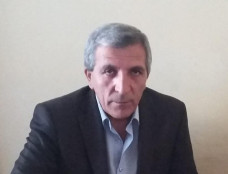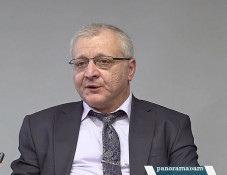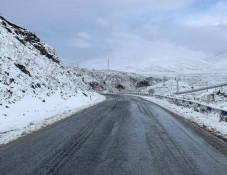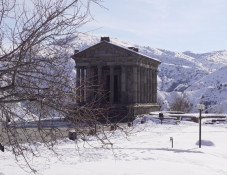
Rouben Galichian: Prominent medieval Ebstorf Map has 4 mentions about Armenia and none about Azerbaijan
The map kept in Hereford Cathedral in England and compiled between 1280 and 1289, is one of the most important medieval world maps, writes famous cartographer Rouben Galichian in his book Historical and Geographical Falsifications of Azerbaijan, a historical, cultural and cartographical research based on a detailed analysis backed by documentary evidence.
Due to its big sizes (162x135х132 cm), Hereford Mappa Mundi or World Map of Hereford includes excerpts from the Bible and ancient legends apart from the geographic details, as well as drawings of miniatures of overseas fantastical animals. “It is the only surviving large medieval map, which is perfectly preserved,” Galichian writes.
The detail of the map presented in Galichian’s book shows the area of the southern Caucasus. Here Armenia appears to the rights from the centre (1). Noah’s Ark (4) is described as ‘Archa noe sedit in montibus armenie’ (Noah’s Ark sitting on Armenian Mountains). Below it, to the right of the Ark is Armenia Inferior (Lesser, 3), marked in red. Armenia Superior (Greater, 2) appears between the Ark and a horizontal tower. On the map, Aghvank (20) is situated at the edge of the map, by the northern part of the ocean surrounding the world, and to the west of the Caspian Sea, where it joins the ocean. The region actually occupied by Aghvank in this map is named Hyrcania (16).
“So, Armenia is mentioned several times on the map. Albania is mentioned once and is placed to the north of Armenia. Media, in the basin of Tigris, is mentioned twice. Therefore, it can be concluded that the cartographer described Aghvank and Atrpatakan as two different countries, one being located north of Araks, and the other – south,” Galichian writes.
Next, he refers to one of Ranulf Higden’s maps, where Armenia appears in Asia Minor extending from the north-west of the Mediterranean to the Mountains of Pontus and surrounded with Cappadocia and Mesopotamia. The map shows the Mediterranean Sea, the Mountains of Pontus, Euphrates, Tigris, Armenia, Aghvank, Virk [Georgia], Parthia (which also includes Media according to the text), Paradise, Adam, Eve, the Serpent and the Apple Tree, the Red Sea and the Persian Gulf.
Galichian also cites a reproduction of the Ebstorf Map, often believed to be made by Gervase of Tilbury, the head of Ebstorf Monastery. It was probably compiled along with a book of the same name. “The south-western region of Asia can be seen on the detail of the map where the toponyms of Armenia and neighbouring countries and some other details are noted with cardinal numbers,” Galichian writes presenting translated descriptions from the Ebstorf Map.
The following are the toponyms referring to Armenia: Ararat; Noah’s Ark; Armenia, extending from Cappadocia to the Caspian; the region of Armenia, named after Jason’s companion Arminus and extending from the Taurus to the Caucasus and from Cappadocia to the Caspian Sea; Armenian city of Partav; the tomb of St Bartholomew [one of the Apostles introducing Christianity into Armenia, as the legend has it]; Araks, a river in Armenia, rising from the same mountains as the Euphrates; Alexander’s bridge built over Araks.
Colchis’ toponyms: the land of Colchis [Abkhazia], the place of the Golden Fleece, according to specialists (therefore, Jason arrived here becoming the reason of the war between Greece and Troy).
The description of Aghvank: this is the country of Albania [Aghvank], populated by 26 tribes who are famous for their bright white skin and are born with white hair. The country begins from the west of the Caspian Sea and extends the length of the North Sea through wild places reaching the Meotidian Marshes [Sea of Azov].
“Armenia and Aghvank are mentioned in the descriptions of the Ebstorf Map, while it includes nothing about Azerbaijan or Media,” Galichian writes.
To be continued.
Born in Tabriz, Rouben Galichian is a descendant of refugees from Van who survived the Genocide. He received scholarship and studied engineering at Aston University, Birmingham (UK). Since in 1981, he started to study the rich cartographical heritage in the libraries of the UK and other European countries. His first research, Historic Maps of Armenia (in English), was published in 2004. It was a collection of maps from various libraries and museums in the world, where Armenia was noted, beginning from the 6th century to the present times. His second book, Armenia in World Cartography, was published in Yerevan in 2005. The research ‘Countries South of the Caucasus in Medieval Maps. Armenia, Georgia and Azerbaijan’ (in English and Armenian) was published in 2007. The book The Invention of History (in English) was published in 2009.
In his book Historical and Geographical Falsifications of Azerbaijan, published in 2013, the author details the reasons, aims and methodology of the falsification of the history of Azerbaijan and the countries of the region.
Related news
- Rouben Galichian notes peculiarities of medieval Christian and Islamic Cartography and Azerbaijan’s absence on maps
- Rouben Galichian: Armenia and South Caucasus in early medieval cartographers’ works
- Rouben Galichian: Name Hayastan, Armenia or Ermeniye can be seen practically on all European and Islamic medieval maps
- Rouben Galichian displays Azerbaijanis appropriating written culture and famous individuals of neighbouring peoples
Newsfeed
Videos






























